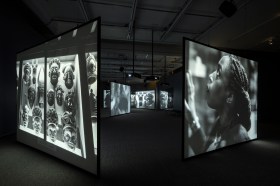Since the turn of the millennium, world concern over environmental issues such as pollution and global warming has increased exponentially.
And as has been the case so often in human history where politicians prove ineffectual in their attempts to address issues of global importance, it has fallen to the artists of the world to work towards advocating change on the environmental front.
By attempting to address what many see as being largely unmet collective cultural needs, new art forms have evolved in turn to address the rapidly changing relationships between nature and society as it exists today.
Eco-art, as it was first called, emerged in the 1960’s as a direct response to the newly emerging environmental movement.
Initially intended to “facilitate a sustainable balance between human and non-human nature through restoration, education, and multidisciplinary collaboration…” according to noted environmental art theorist Celia Lerner, the discipline was “grounded in an ethos that focused on interrelationships, including not only physical and biological pathways but also the cultural, political and historical aspects of ecological systems.”
Famous artists, such as the iconic Christo and Hans Haacke have been combining the forces of art and nature with great effect for decades.
But as the impact of global warming is felt, literally and figuratively, around the world, environmental art is also transforming.
Noted art critic and author John K Grande commented in his book Art Nature Dialogues: Interviews With Environmental Artists that “our civilization is facing an ecological crisis of incredible proportions, and this changes the way we conceive and approach notions of art.”
At this years annual Sundance film festival the most controversial entry was film maker Davis Guggenheim‘s documentary An Inconvenient Truth, offering a brutal survey of the earth’s current environmental health. Central to the film was former US Vice President Al Gore’s decades long crusade to highlight the realities of global warming and ‘environmental genocide’ to an international stage.
In his influential essay entitled The Moment Of Truth, Gore wrote that “the climate crisis may at times appear to be happening slowly, but in fact it is a true planetary emergency….so why is it that our leaders seem not to hear such clarion warnings?’’
Ahmad Nadalian, one of the world’s leading environmental artists, recently declared: “It’s no longer a question of whether we live in a small village or the global village. We live in the age of new technologies and capabilities. These resources have created new difficulties and crises. History has never before witnessed such destruction brought upon nature.”
Increasingly, contemporary artists are feeling a responsibility to advocate attitudinal change through their work with greater frequency and the number of new works being produced on both small and large scales reflects this growing trend.
Put simply, environmental artists try to interpret nature in their work, creating artworks that inform about nature and its processes. They aim to tackle environmental problems and hopefully help humanity to reinterpret its relationship with nature, proposing through their work new ways for man to co-exist with his environment.
The creation in 1994 of the Earth Charter, a “declaration of the fundamental principles for building a just society with a special emphasis of the world’s environmental challenges,” has a major influence on environmental artists.
The document laid out the roadmap for a world where “environmental protection, human rights, equitable human development, and peace are interdependent and indivisible” – a vision many artists have adopted as their own.
Australian based artist John Dahlsen, famous for his works using found objects in the form of plastic debris washed up in ever growing amounts on Australian beaches, credited the creation of the Earth Charter with redefining the focus of his work and the messages he felt the need to communicate.
The artist was invited to both curate and participate in Recycled Revisited – Artistic Responses to the Earth Charter, a 2005 exhibtion in New York. “My challenge as an artist was to take these found objects, which might on first meeting have no apparent dialogue, and to work with them until they spoke and told their story, which importantly included those underlying environmental messages inherent in the use of this kind of medium”.
So too, influential environmental artist Lynne Hull notes a change in the direction of her work: “I am in search of a new compact between the species who share the world…in search of a life with reduced impact on the other species who so enrich our time on this planet”.
On a larger scale, the UK’s Royal Society for the Encouragement Of Arts, Manufacture and Commerce (RSA) recently unveiled a new initiative to “profile, encourage and support artists in addressing ecological concerns”.
The program has already championed numerous events that feature art and artists across multiple art forms, concerned with the state of the environment today.
Even with such support, artists can only do so much. If ‘eco-art’ is to rise beyond its grass roots, it must be recognised as a critical means of communicating message on mass.
Says Ruth Wallen, one of the planet’s most respected environmental artists and a key figure in the modern day eco-art movement: “[Eco-art can] engender an intuitive appreciation of the environment, address core values, advocate political action, and broaden intellectual understanding of the state of the world today.” Ahmad Nadalian agrees: “Environmental art can play an important role,” he said. “Art is capable of illustrating the crisis, critiquing its conditions, and describing a utopian world.” And if you can visualize it, you’re halfway there.




